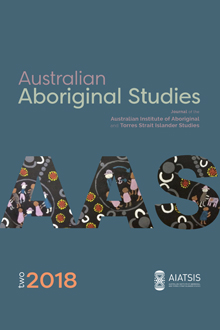Australian Aboriginal Studies: Issue 2, 2018
Abstracts
Photostory and relatedness methodology: the beginning of an Aboriginal–Kanaka Maoli research journey (part one) - Jessa Rogers
Abstract: This paper outlines how an Aboriginal researcher approached international indigenous research based on indigenous research practices and principles, indigenous worldview and Country-based ontologies.1 In particular, this paper discusses how relatedness functions as a methodology in collaborative indigenous work and how photostory, a modified version of the method termed ‘photoyarn’, was developed specifically for Kanaka Mãoli young people attending boarding school with noho. To ‘noho’ means to ‘commit to the establishment of the relationship and to maintain it with humility and respect’ (Lopes 2016:32). Opening with the connections that bind Aboriginal, Mãori, Kanaka Maoli and Native peoples of North America, this paper presents photostory as a method and outlines how cross-cultural research can function from an Aboriginal perspective.
A story of two paintings: ‘That’s not what I meant, but is that what you want to say?’ - Emily Fitzpatrick
Abstract: A picture is worth a thousand words, but the paintings I discuss in this paper capture what words could not. The Picture Talk Project commissioned Australian Aboriginal artists to paint research results, to be used as a visual medium to present findings back to the Aboriginal communities. However, the way in which the artists were briefed, the process of creation and the artists’ lived experiences all emerged in the paintings. The process reinforces the fact that efforts to ensure greater collaboration take place within a long history of power inequities. The experience is a sober reminder that we must embody appropriate cultural frameworks of communication every step of the way.
Opportunities and resilience: enablers to address barriers for Aboriginal and Torres Strait Islander people to commence and complete higher degree research programs - Kate Hutchings, Kerry Bodle and Adrian Miller
Abstract: Although the number of Aboriginal and Torres Strait Islander (hereafter Indigenous) people completing undergraduate degrees has improved markedly in recent years, Indigenous people remain under-represented in higher degree research (HDR) programs, which limits progression into academic careers. This paper explores factors affecting Indigenous people’s commencement and completion of HDR programs. The research was undertaken at a large, multi-campus, metropolitan Australian university and involved a qualitative, culturally appropriate research design based on yarning circles and interviews with Indigenous HDR candidates and interviews with HDR supervisors. The research was undertaken by Indigenous and non-Indigenous researchers with advice provided by the Indigenous community at the university to ensure cultural safety. Highlighting the central role of supervisors and system-wide university support, the most significant finding of the research is that although additional research and university commitments can be barriers, other research/ work opportunities enable completion. The findings suggest that in addressing under-representation of Indigenous people in HDR and academia in Australia, universities need to provide strategic attention to how they engage, support and recognise achievements of Indigenous people in HDR while also being cognisant of individuals’ competing responsibilities.
Aboriginal and Torres Strait Islander people's attitudes towards Australian multiculturalism, cultural diversity, ‘race’ and racism, 2015–16 - Alanna Kamp, Kevin Dunn, Yin Paradies and Kathleen Blair
Abstract: A perception exists that Aboriginal and Torres Strait Islander people are uneasy with cultural diversity. Such unease has been attributed to problematic positioning of Aboriginal and Torres Strait Islander people within multicultural policy, and the requirement that Aboriginal and Torres Strait Islander people declare an overriding and primary commitment to the Australian nation-state. Furthermore, the lack of a formal treaty, absence of constitutional recognition and continuing experiences of racism mean that the encounter with the multicultural nation-state is colonialist. We present nationwide survey data collected between July and August 2015 and in November 2016 revealing that Aboriginal and Torres Strait Islander people are largely supportive of diversity, which is one of the central tenets of multiculturalism. In most respects, Aboriginal and Torres Strait Islander respondents’ attitudes towards cultural diversity and views on ‘old racism’ are similar to those of non-Aboriginal and Torres Strait Islander people, despite their higher reported experiences of racism. Aboriginal and Torres Strait Islander people are more likely to acknowledge racism and Anglo privilege, and have more negative views on inter-racial marriage, especially with white Australians. While there is evidence of some support for cultural diversity among the Aboriginal and Torres Strait Islander respondents, the data reveal that, as a group, they are not as supportive as non- Indigenous Australians, demonstrating some levels of unease with cultural diversity.
Working side by side: a process of collaboration for Aboriginal and non-Aboriginal people - Jacqui Sundbery and Robyne Latham
Abstract: The need for collaborative approaches has both an ethical and pragmatic imperative in the fields of Aboriginal and Torres Strait Islander health, education and research. It has been argued that both Aboriginal and Torres Strait Islander people and non-Indigenous people are not adequately equipped to address inequity in contemporary Australia without an understanding of both Indigenous and Western knowledge systems. Towards developing this capacity, a collaboration between differing knowledge systems can result in a kind of ‘gestalt leap’ or ‘third space’. Examples of this exchange include Anangu concepts such as Malparara and Ngapartji Ngapartji. Mindful of this argument, the authors of this paper have found a limited literature on the process and benefits of collaborations that bring together the disparate knowledge systems of Indigenous and non-Indigenous cultures. This paper contributes to the development of such a literature and focuses upon the processes by which these benefits may be maximised.
